Factors Affecting Sustainable Funding of Kenyan NGOs: A Study
VerifiedAdded on 2020/02/03
|13
|4446
|149
Report
AI Summary
This report investigates the factors affecting sustainable funding of Non-Governmental Organizations (NGOs) in Kenya, with a specific focus on the Shade Children Foundation in Thika. The study explores the impact of income diversification, strategic financial management, participation in income-generating activities, and donor relationship management on NGO funding sustainability. The research employs an exploratory research design using a case study method, collecting primary data through questionnaires administered to the management team. The methodology includes stratified proportionate random sampling to select a sample of 67 respondents from a target population of 223. The literature review covers theoretical perspectives, including the resource-based view, and the research design outlines the data collection and analysis procedures. The study aims to provide insights into strategic practices and how they can help diverse NGOs sustain funding, offering valuable information for NGO managers, researchers, and academics. The report highlights the importance of good financial management, accountability, and transparency in attracting and maintaining donor funding, addressing the challenges of resource scarcity that often characterize the financial management processes of non-profit organizations.
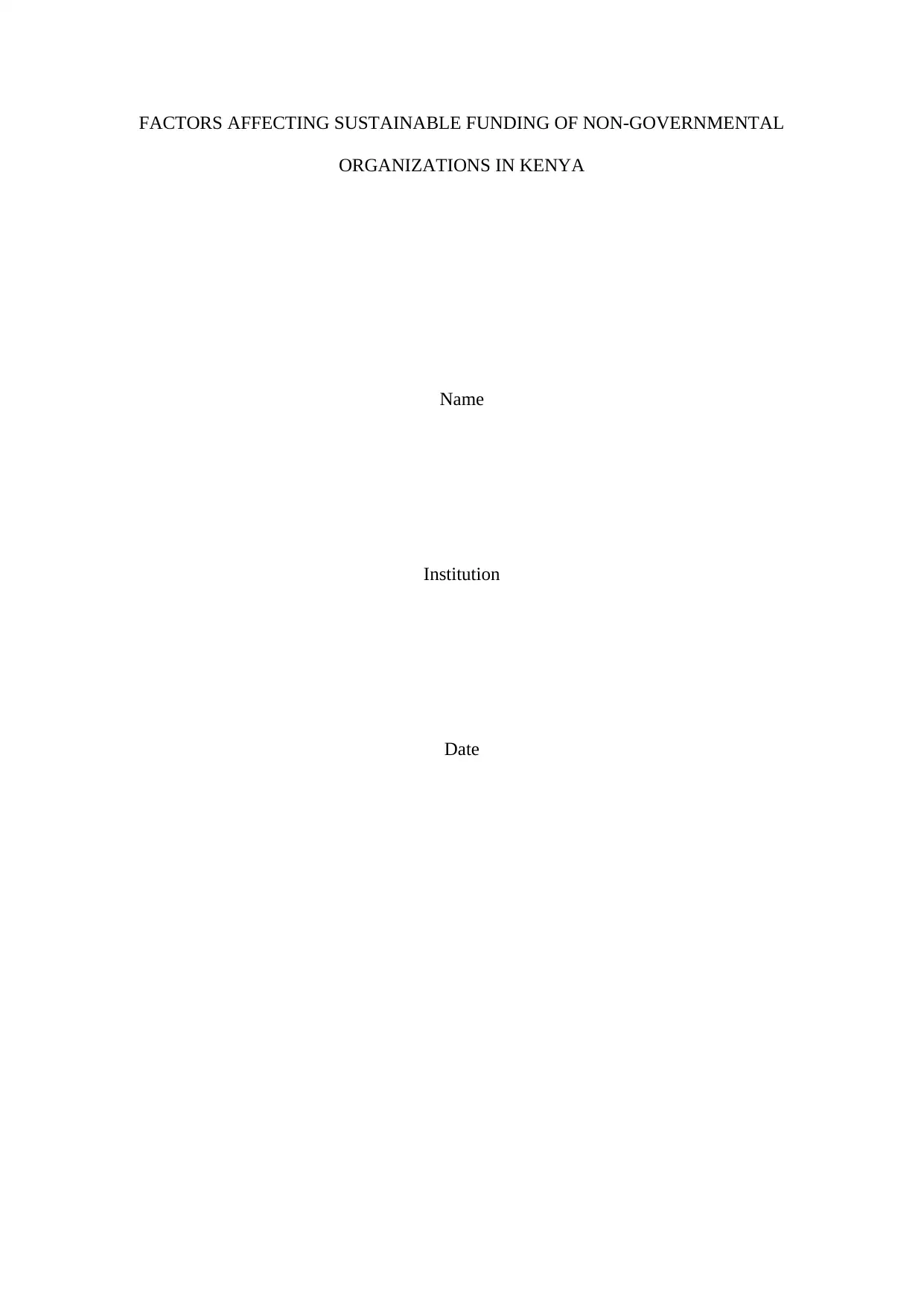
FACTORS AFFECTING SUSTAINABLE FUNDING OF NON-GOVERNMENTAL
ORGANIZATIONS IN KENYA
Name
Institution
Date
ORGANIZATIONS IN KENYA
Name
Institution
Date
Paraphrase This Document
Need a fresh take? Get an instant paraphrase of this document with our AI Paraphraser
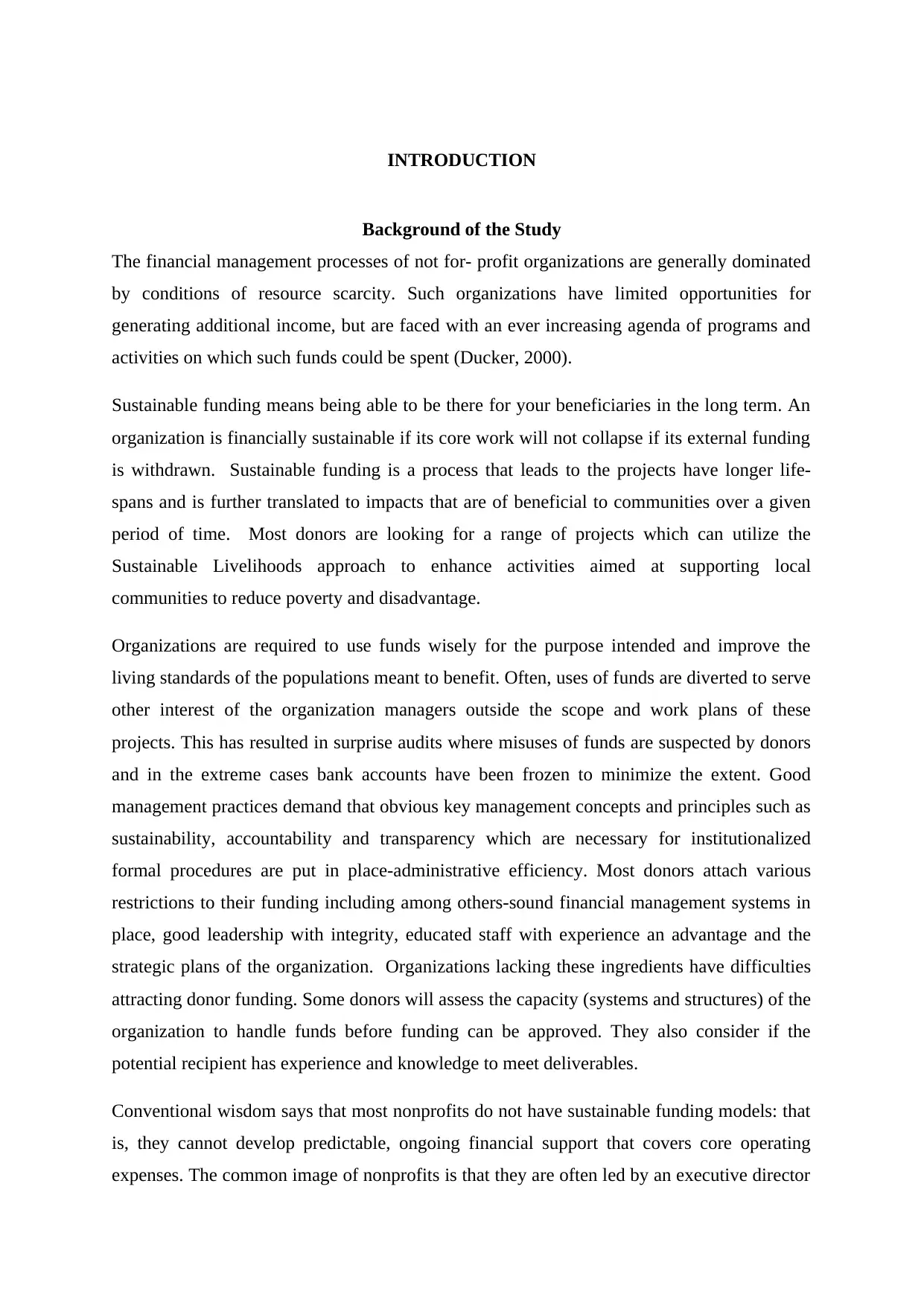
INTRODUCTION
Background of the Study
The financial management processes of not for- profit organizations are generally dominated
by conditions of resource scarcity. Such organizations have limited opportunities for
generating additional income, but are faced with an ever increasing agenda of programs and
activities on which such funds could be spent (Ducker, 2000).
Sustainable funding means being able to be there for your beneficiaries in the long term. An
organization is financially sustainable if its core work will not collapse if its external funding
is withdrawn. Sustainable funding is a process that leads to the projects have longer life-
spans and is further translated to impacts that are of beneficial to communities over a given
period of time. Most donors are looking for a range of projects which can utilize the
Sustainable Livelihoods approach to enhance activities aimed at supporting local
communities to reduce poverty and disadvantage.
Organizations are required to use funds wisely for the purpose intended and improve the
living standards of the populations meant to benefit. Often, uses of funds are diverted to serve
other interest of the organization managers outside the scope and work plans of these
projects. This has resulted in surprise audits where misuses of funds are suspected by donors
and in the extreme cases bank accounts have been frozen to minimize the extent. Good
management practices demand that obvious key management concepts and principles such as
sustainability, accountability and transparency which are necessary for institutionalized
formal procedures are put in place-administrative efficiency. Most donors attach various
restrictions to their funding including among others-sound financial management systems in
place, good leadership with integrity, educated staff with experience an advantage and the
strategic plans of the organization. Organizations lacking these ingredients have difficulties
attracting donor funding. Some donors will assess the capacity (systems and structures) of the
organization to handle funds before funding can be approved. They also consider if the
potential recipient has experience and knowledge to meet deliverables.
Conventional wisdom says that most nonprofits do not have sustainable funding models: that
is, they cannot develop predictable, ongoing financial support that covers core operating
expenses. The common image of nonprofits is that they are often led by an executive director
Background of the Study
The financial management processes of not for- profit organizations are generally dominated
by conditions of resource scarcity. Such organizations have limited opportunities for
generating additional income, but are faced with an ever increasing agenda of programs and
activities on which such funds could be spent (Ducker, 2000).
Sustainable funding means being able to be there for your beneficiaries in the long term. An
organization is financially sustainable if its core work will not collapse if its external funding
is withdrawn. Sustainable funding is a process that leads to the projects have longer life-
spans and is further translated to impacts that are of beneficial to communities over a given
period of time. Most donors are looking for a range of projects which can utilize the
Sustainable Livelihoods approach to enhance activities aimed at supporting local
communities to reduce poverty and disadvantage.
Organizations are required to use funds wisely for the purpose intended and improve the
living standards of the populations meant to benefit. Often, uses of funds are diverted to serve
other interest of the organization managers outside the scope and work plans of these
projects. This has resulted in surprise audits where misuses of funds are suspected by donors
and in the extreme cases bank accounts have been frozen to minimize the extent. Good
management practices demand that obvious key management concepts and principles such as
sustainability, accountability and transparency which are necessary for institutionalized
formal procedures are put in place-administrative efficiency. Most donors attach various
restrictions to their funding including among others-sound financial management systems in
place, good leadership with integrity, educated staff with experience an advantage and the
strategic plans of the organization. Organizations lacking these ingredients have difficulties
attracting donor funding. Some donors will assess the capacity (systems and structures) of the
organization to handle funds before funding can be approved. They also consider if the
potential recipient has experience and knowledge to meet deliverables.
Conventional wisdom says that most nonprofits do not have sustainable funding models: that
is, they cannot develop predictable, ongoing financial support that covers core operating
expenses. The common image of nonprofits is that they are often led by an executive director
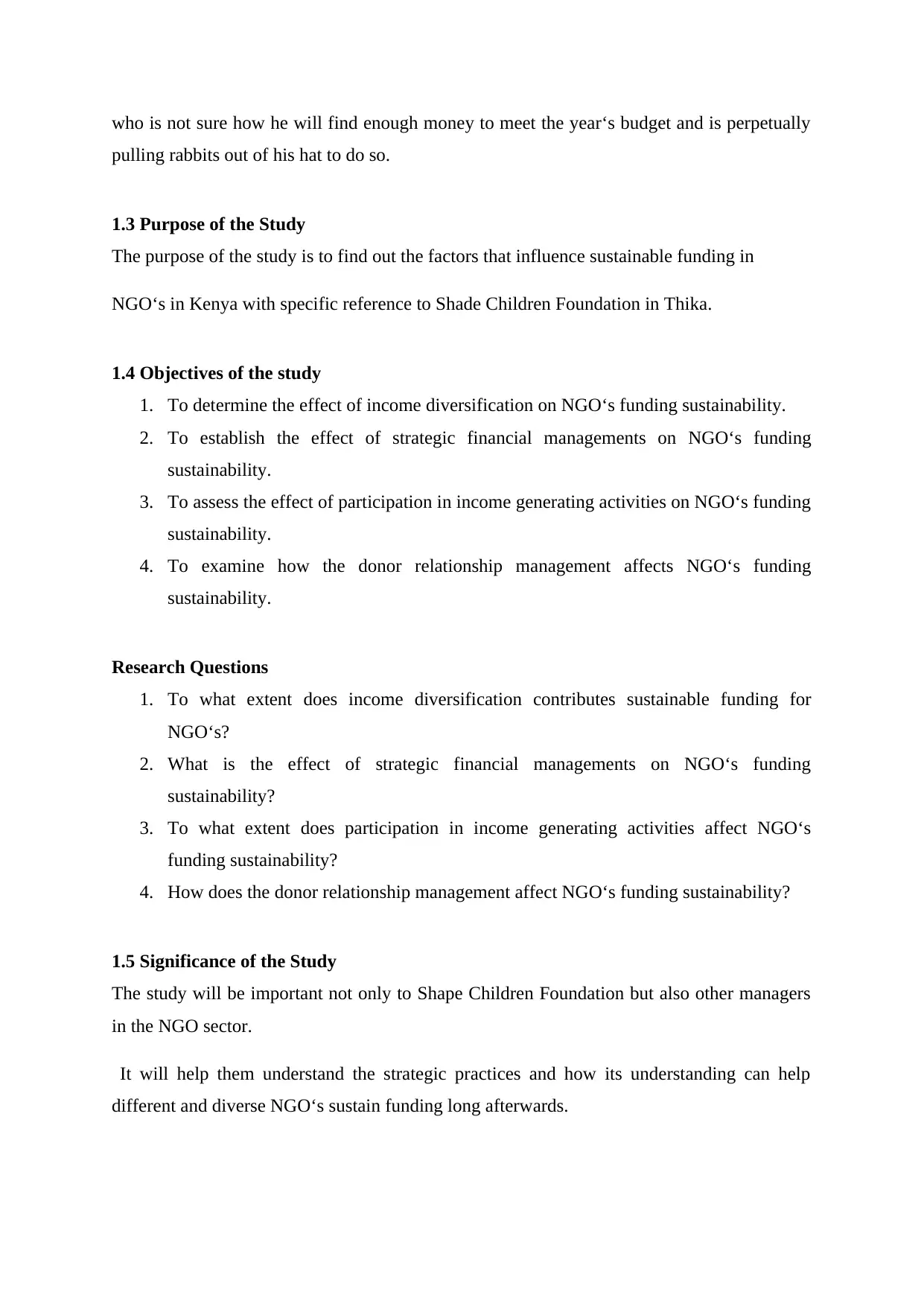
who is not sure how he will find enough money to meet the year‘s budget and is perpetually
pulling rabbits out of his hat to do so.
1.3 Purpose of the Study
The purpose of the study is to find out the factors that influence sustainable funding in
NGO‘s in Kenya with specific reference to Shade Children Foundation in Thika.
1.4 Objectives of the study
1. To determine the effect of income diversification on NGO‘s funding sustainability.
2. To establish the effect of strategic financial managements on NGO‘s funding
sustainability.
3. To assess the effect of participation in income generating activities on NGO‘s funding
sustainability.
4. To examine how the donor relationship management affects NGO‘s funding
sustainability.
Research Questions
1. To what extent does income diversification contributes sustainable funding for
NGO‘s?
2. What is the effect of strategic financial managements on NGO‘s funding
sustainability?
3. To what extent does participation in income generating activities affect NGO‘s
funding sustainability?
4. How does the donor relationship management affect NGO‘s funding sustainability?
1.5 Significance of the Study
The study will be important not only to Shape Children Foundation but also other managers
in the NGO sector.
It will help them understand the strategic practices and how its understanding can help
different and diverse NGO‘s sustain funding long afterwards.
pulling rabbits out of his hat to do so.
1.3 Purpose of the Study
The purpose of the study is to find out the factors that influence sustainable funding in
NGO‘s in Kenya with specific reference to Shade Children Foundation in Thika.
1.4 Objectives of the study
1. To determine the effect of income diversification on NGO‘s funding sustainability.
2. To establish the effect of strategic financial managements on NGO‘s funding
sustainability.
3. To assess the effect of participation in income generating activities on NGO‘s funding
sustainability.
4. To examine how the donor relationship management affects NGO‘s funding
sustainability.
Research Questions
1. To what extent does income diversification contributes sustainable funding for
NGO‘s?
2. What is the effect of strategic financial managements on NGO‘s funding
sustainability?
3. To what extent does participation in income generating activities affect NGO‘s
funding sustainability?
4. How does the donor relationship management affect NGO‘s funding sustainability?
1.5 Significance of the Study
The study will be important not only to Shape Children Foundation but also other managers
in the NGO sector.
It will help them understand the strategic practices and how its understanding can help
different and diverse NGO‘s sustain funding long afterwards.
⊘ This is a preview!⊘
Do you want full access?
Subscribe today to unlock all pages.

Trusted by 1+ million students worldwide
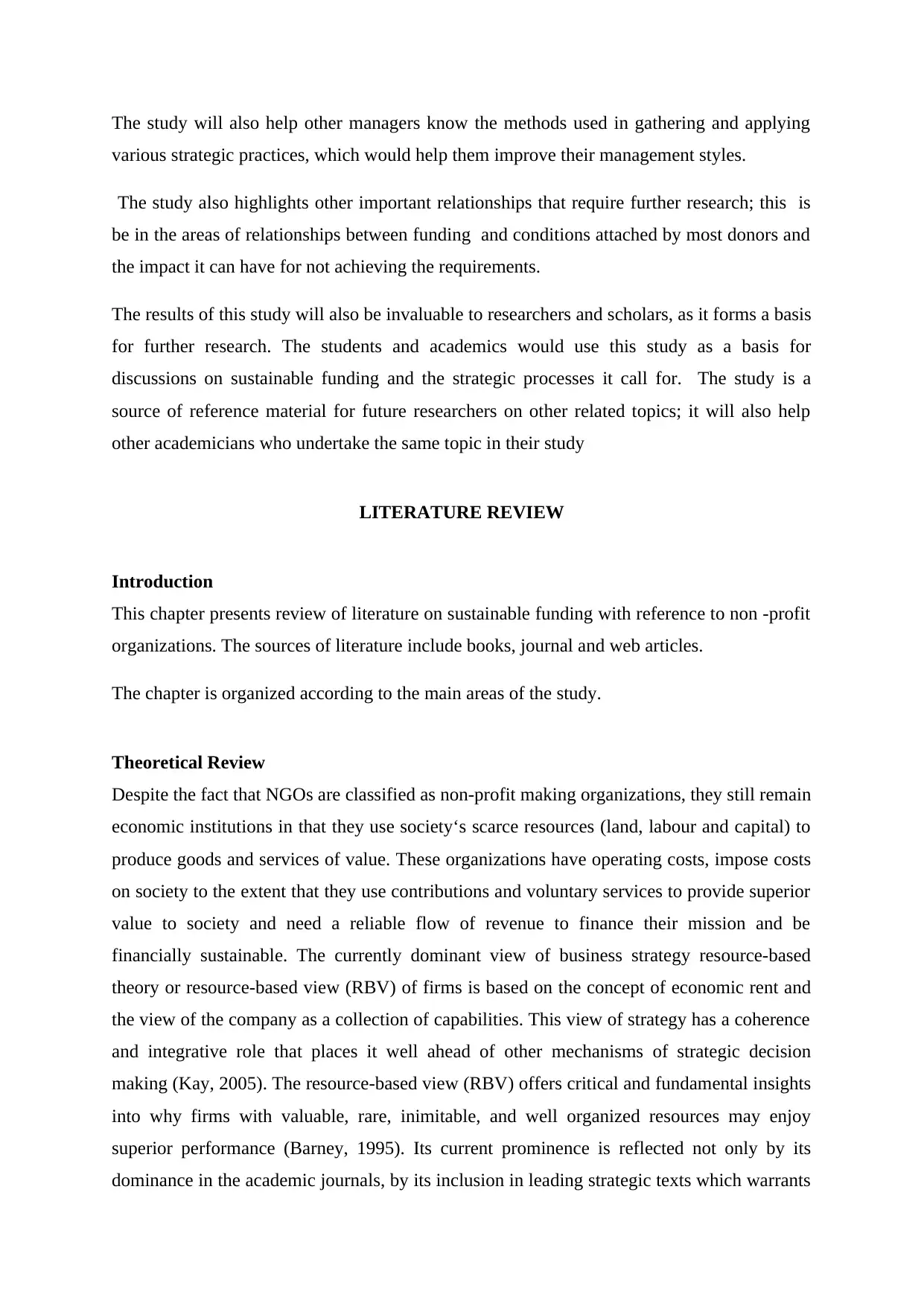
The study will also help other managers know the methods used in gathering and applying
various strategic practices, which would help them improve their management styles.
The study also highlights other important relationships that require further research; this is
be in the areas of relationships between funding and conditions attached by most donors and
the impact it can have for not achieving the requirements.
The results of this study will also be invaluable to researchers and scholars, as it forms a basis
for further research. The students and academics would use this study as a basis for
discussions on sustainable funding and the strategic processes it call for. The study is a
source of reference material for future researchers on other related topics; it will also help
other academicians who undertake the same topic in their study
LITERATURE REVIEW
Introduction
This chapter presents review of literature on sustainable funding with reference to non -profit
organizations. The sources of literature include books, journal and web articles.
The chapter is organized according to the main areas of the study.
Theoretical Review
Despite the fact that NGOs are classified as non-profit making organizations, they still remain
economic institutions in that they use society‘s scarce resources (land, labour and capital) to
produce goods and services of value. These organizations have operating costs, impose costs
on society to the extent that they use contributions and voluntary services to provide superior
value to society and need a reliable flow of revenue to finance their mission and be
financially sustainable. The currently dominant view of business strategy resource-based
theory or resource-based view (RBV) of firms is based on the concept of economic rent and
the view of the company as a collection of capabilities. This view of strategy has a coherence
and integrative role that places it well ahead of other mechanisms of strategic decision
making (Kay, 2005). The resource-based view (RBV) offers critical and fundamental insights
into why firms with valuable, rare, inimitable, and well organized resources may enjoy
superior performance (Barney, 1995). Its current prominence is reflected not only by its
dominance in the academic journals, by its inclusion in leading strategic texts which warrants
various strategic practices, which would help them improve their management styles.
The study also highlights other important relationships that require further research; this is
be in the areas of relationships between funding and conditions attached by most donors and
the impact it can have for not achieving the requirements.
The results of this study will also be invaluable to researchers and scholars, as it forms a basis
for further research. The students and academics would use this study as a basis for
discussions on sustainable funding and the strategic processes it call for. The study is a
source of reference material for future researchers on other related topics; it will also help
other academicians who undertake the same topic in their study
LITERATURE REVIEW
Introduction
This chapter presents review of literature on sustainable funding with reference to non -profit
organizations. The sources of literature include books, journal and web articles.
The chapter is organized according to the main areas of the study.
Theoretical Review
Despite the fact that NGOs are classified as non-profit making organizations, they still remain
economic institutions in that they use society‘s scarce resources (land, labour and capital) to
produce goods and services of value. These organizations have operating costs, impose costs
on society to the extent that they use contributions and voluntary services to provide superior
value to society and need a reliable flow of revenue to finance their mission and be
financially sustainable. The currently dominant view of business strategy resource-based
theory or resource-based view (RBV) of firms is based on the concept of economic rent and
the view of the company as a collection of capabilities. This view of strategy has a coherence
and integrative role that places it well ahead of other mechanisms of strategic decision
making (Kay, 2005). The resource-based view (RBV) offers critical and fundamental insights
into why firms with valuable, rare, inimitable, and well organized resources may enjoy
superior performance (Barney, 1995). Its current prominence is reflected not only by its
dominance in the academic journals, by its inclusion in leading strategic texts which warrants
Paraphrase This Document
Need a fresh take? Get an instant paraphrase of this document with our AI Paraphraser
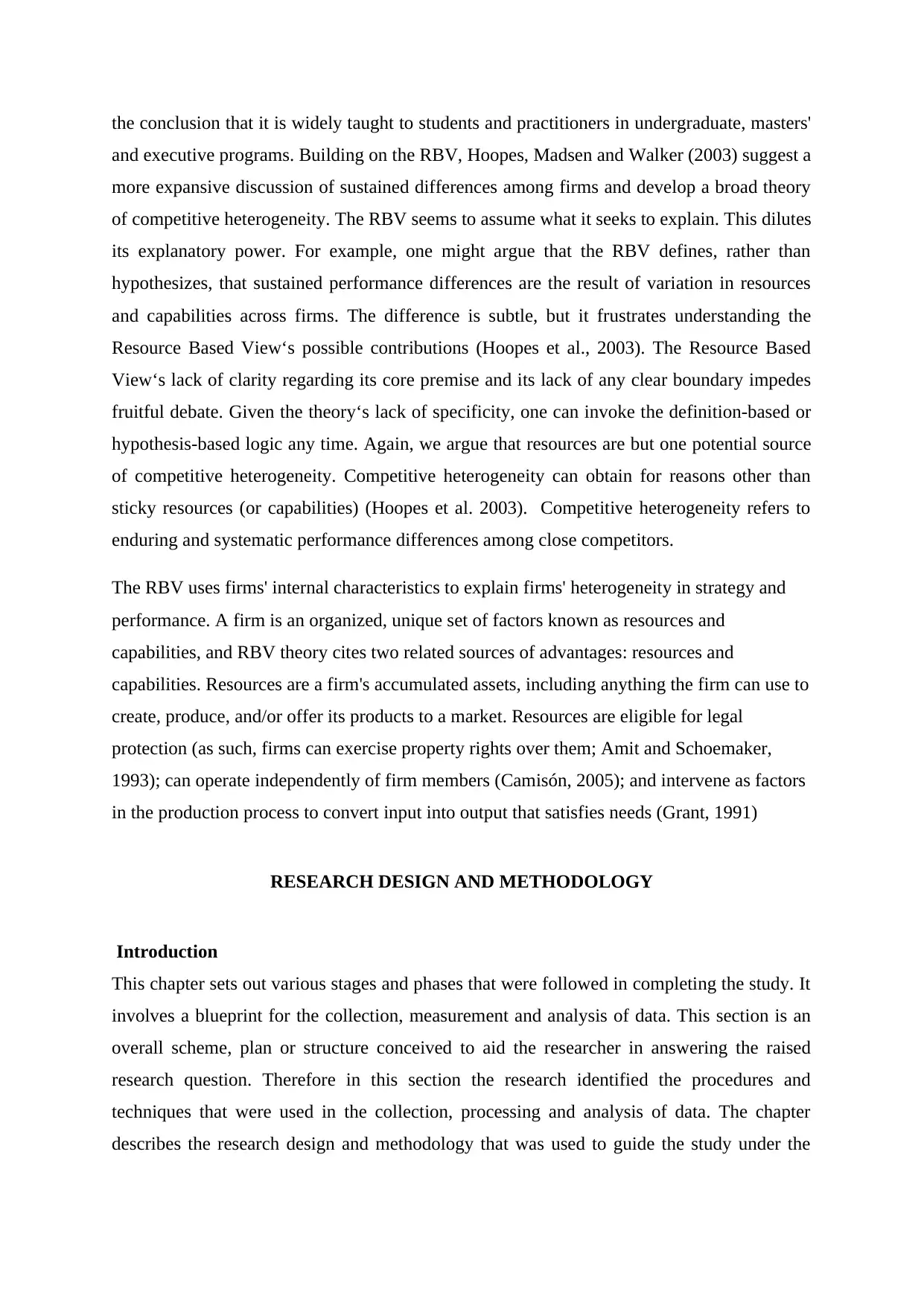
the conclusion that it is widely taught to students and practitioners in undergraduate, masters'
and executive programs. Building on the RBV, Hoopes, Madsen and Walker (2003) suggest a
more expansive discussion of sustained differences among firms and develop a broad theory
of competitive heterogeneity. The RBV seems to assume what it seeks to explain. This dilutes
its explanatory power. For example, one might argue that the RBV defines, rather than
hypothesizes, that sustained performance differences are the result of variation in resources
and capabilities across firms. The difference is subtle, but it frustrates understanding the
Resource Based View‘s possible contributions (Hoopes et al., 2003). The Resource Based
View‘s lack of clarity regarding its core premise and its lack of any clear boundary impedes
fruitful debate. Given the theory‘s lack of specificity, one can invoke the definition-based or
hypothesis-based logic any time. Again, we argue that resources are but one potential source
of competitive heterogeneity. Competitive heterogeneity can obtain for reasons other than
sticky resources (or capabilities) (Hoopes et al. 2003). Competitive heterogeneity refers to
enduring and systematic performance differences among close competitors.
The RBV uses firms' internal characteristics to explain firms' heterogeneity in strategy and
performance. A firm is an organized, unique set of factors known as resources and
capabilities, and RBV theory cites two related sources of advantages: resources and
capabilities. Resources are a firm's accumulated assets, including anything the firm can use to
create, produce, and/or offer its products to a market. Resources are eligible for legal
protection (as such, firms can exercise property rights over them; Amit and Schoemaker,
1993); can operate independently of firm members (Camisón, 2005); and intervene as factors
in the production process to convert input into output that satisfies needs (Grant, 1991)
RESEARCH DESIGN AND METHODOLOGY
Introduction
This chapter sets out various stages and phases that were followed in completing the study. It
involves a blueprint for the collection, measurement and analysis of data. This section is an
overall scheme, plan or structure conceived to aid the researcher in answering the raised
research question. Therefore in this section the research identified the procedures and
techniques that were used in the collection, processing and analysis of data. The chapter
describes the research design and methodology that was used to guide the study under the
and executive programs. Building on the RBV, Hoopes, Madsen and Walker (2003) suggest a
more expansive discussion of sustained differences among firms and develop a broad theory
of competitive heterogeneity. The RBV seems to assume what it seeks to explain. This dilutes
its explanatory power. For example, one might argue that the RBV defines, rather than
hypothesizes, that sustained performance differences are the result of variation in resources
and capabilities across firms. The difference is subtle, but it frustrates understanding the
Resource Based View‘s possible contributions (Hoopes et al., 2003). The Resource Based
View‘s lack of clarity regarding its core premise and its lack of any clear boundary impedes
fruitful debate. Given the theory‘s lack of specificity, one can invoke the definition-based or
hypothesis-based logic any time. Again, we argue that resources are but one potential source
of competitive heterogeneity. Competitive heterogeneity can obtain for reasons other than
sticky resources (or capabilities) (Hoopes et al. 2003). Competitive heterogeneity refers to
enduring and systematic performance differences among close competitors.
The RBV uses firms' internal characteristics to explain firms' heterogeneity in strategy and
performance. A firm is an organized, unique set of factors known as resources and
capabilities, and RBV theory cites two related sources of advantages: resources and
capabilities. Resources are a firm's accumulated assets, including anything the firm can use to
create, produce, and/or offer its products to a market. Resources are eligible for legal
protection (as such, firms can exercise property rights over them; Amit and Schoemaker,
1993); can operate independently of firm members (Camisón, 2005); and intervene as factors
in the production process to convert input into output that satisfies needs (Grant, 1991)
RESEARCH DESIGN AND METHODOLOGY
Introduction
This chapter sets out various stages and phases that were followed in completing the study. It
involves a blueprint for the collection, measurement and analysis of data. This section is an
overall scheme, plan or structure conceived to aid the researcher in answering the raised
research question. Therefore in this section the research identified the procedures and
techniques that were used in the collection, processing and analysis of data. The chapter
describes the research design and methodology that was used to guide the study under the
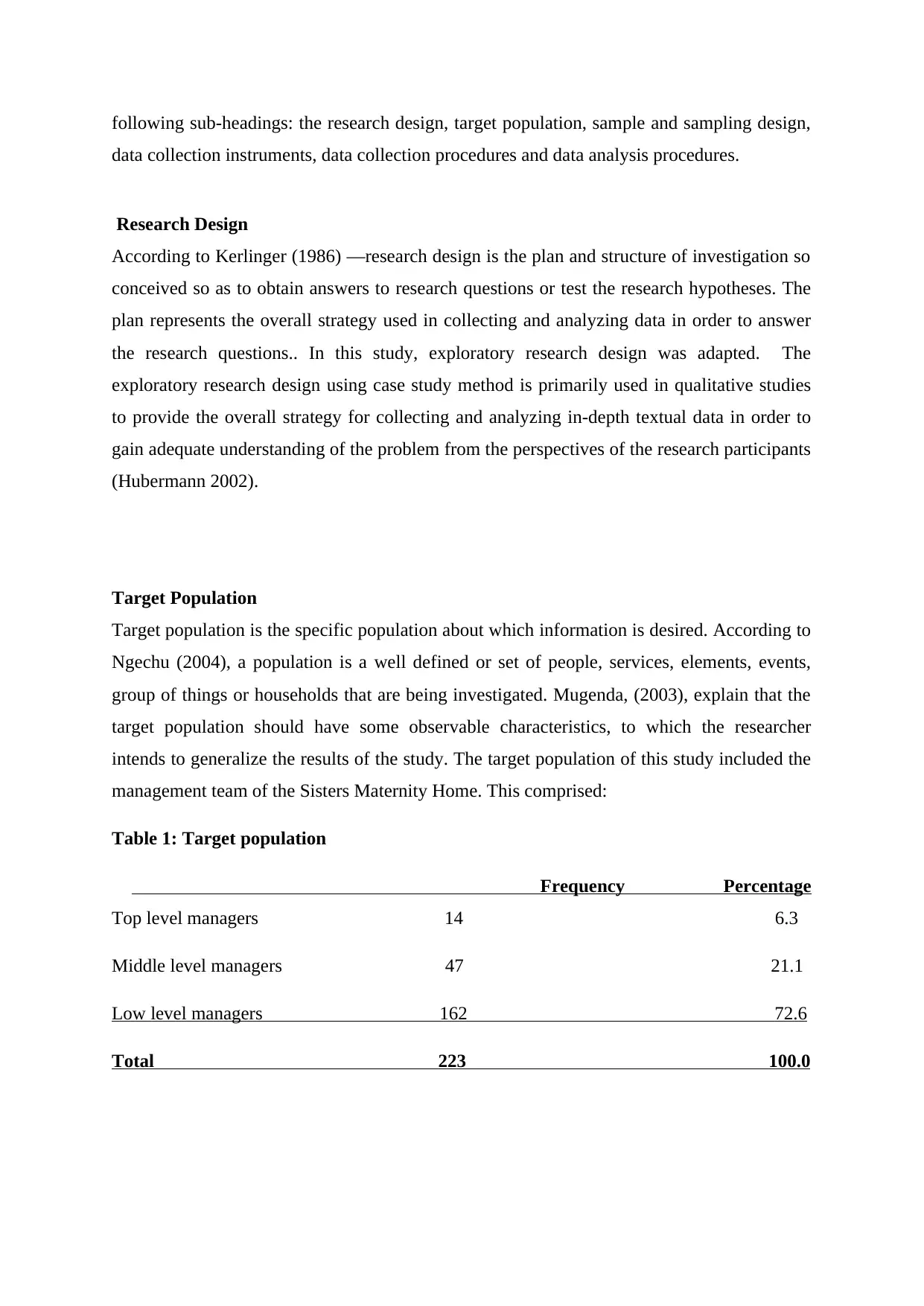
following sub-headings: the research design, target population, sample and sampling design,
data collection instruments, data collection procedures and data analysis procedures.
Research Design
According to Kerlinger (1986) ―research design is the plan and structure of investigation so
conceived so as to obtain answers to research questions or test the research hypotheses. The
plan represents the overall strategy used in collecting and analyzing data in order to answer
the research questions.. In this study, exploratory research design was adapted. The
exploratory research design using case study method is primarily used in qualitative studies
to provide the overall strategy for collecting and analyzing in-depth textual data in order to
gain adequate understanding of the problem from the perspectives of the research participants
(Hubermann 2002).
Target Population
Target population is the specific population about which information is desired. According to
Ngechu (2004), a population is a well defined or set of people, services, elements, events,
group of things or households that are being investigated. Mugenda, (2003), explain that the
target population should have some observable characteristics, to which the researcher
intends to generalize the results of the study. The target population of this study included the
management team of the Sisters Maternity Home. This comprised:
Table 1: Target population
Frequency Percentage
Top level managers 14 6.3
Middle level managers 47 21.1
Low level managers 162 72.6
Total 223 100.0
data collection instruments, data collection procedures and data analysis procedures.
Research Design
According to Kerlinger (1986) ―research design is the plan and structure of investigation so
conceived so as to obtain answers to research questions or test the research hypotheses. The
plan represents the overall strategy used in collecting and analyzing data in order to answer
the research questions.. In this study, exploratory research design was adapted. The
exploratory research design using case study method is primarily used in qualitative studies
to provide the overall strategy for collecting and analyzing in-depth textual data in order to
gain adequate understanding of the problem from the perspectives of the research participants
(Hubermann 2002).
Target Population
Target population is the specific population about which information is desired. According to
Ngechu (2004), a population is a well defined or set of people, services, elements, events,
group of things or households that are being investigated. Mugenda, (2003), explain that the
target population should have some observable characteristics, to which the researcher
intends to generalize the results of the study. The target population of this study included the
management team of the Sisters Maternity Home. This comprised:
Table 1: Target population
Frequency Percentage
Top level managers 14 6.3
Middle level managers 47 21.1
Low level managers 162 72.6
Total 223 100.0
⊘ This is a preview!⊘
Do you want full access?
Subscribe today to unlock all pages.

Trusted by 1+ million students worldwide
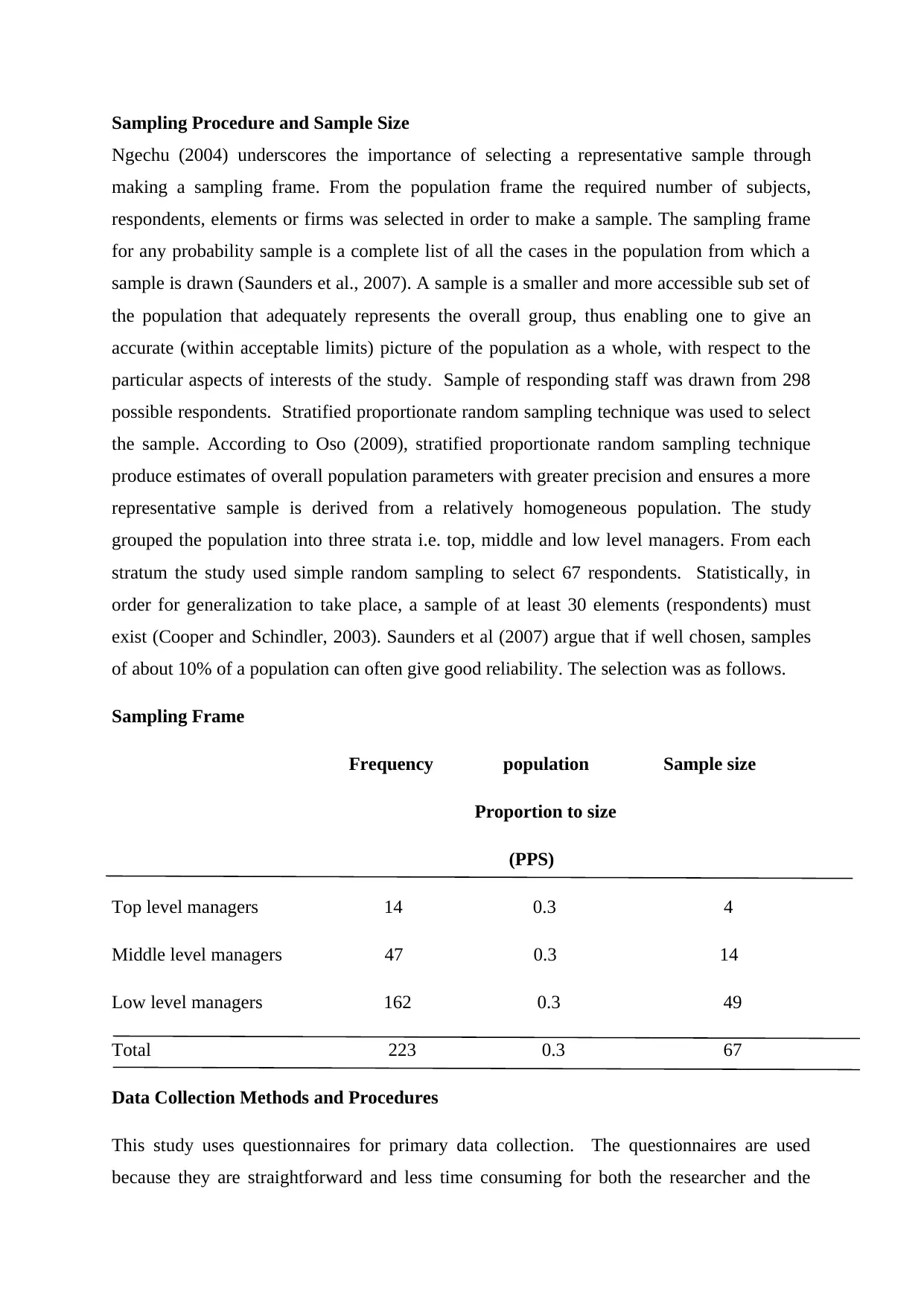
Sampling Procedure and Sample Size
Ngechu (2004) underscores the importance of selecting a representative sample through
making a sampling frame. From the population frame the required number of subjects,
respondents, elements or firms was selected in order to make a sample. The sampling frame
for any probability sample is a complete list of all the cases in the population from which a
sample is drawn (Saunders et al., 2007). A sample is a smaller and more accessible sub set of
the population that adequately represents the overall group, thus enabling one to give an
accurate (within acceptable limits) picture of the population as a whole, with respect to the
particular aspects of interests of the study. Sample of responding staff was drawn from 298
possible respondents. Stratified proportionate random sampling technique was used to select
the sample. According to Oso (2009), stratified proportionate random sampling technique
produce estimates of overall population parameters with greater precision and ensures a more
representative sample is derived from a relatively homogeneous population. The study
grouped the population into three strata i.e. top, middle and low level managers. From each
stratum the study used simple random sampling to select 67 respondents. Statistically, in
order for generalization to take place, a sample of at least 30 elements (respondents) must
exist (Cooper and Schindler, 2003). Saunders et al (2007) argue that if well chosen, samples
of about 10% of a population can often give good reliability. The selection was as follows.
Sampling Frame
Frequency population Sample size
Proportion to size
(PPS)
Top level managers 14 0.3 4
Middle level managers 47 0.3 14
Low level managers 162 0.3 49
Total 223 0.3 67
Data Collection Methods and Procedures
This study uses questionnaires for primary data collection. The questionnaires are used
because they are straightforward and less time consuming for both the researcher and the
Ngechu (2004) underscores the importance of selecting a representative sample through
making a sampling frame. From the population frame the required number of subjects,
respondents, elements or firms was selected in order to make a sample. The sampling frame
for any probability sample is a complete list of all the cases in the population from which a
sample is drawn (Saunders et al., 2007). A sample is a smaller and more accessible sub set of
the population that adequately represents the overall group, thus enabling one to give an
accurate (within acceptable limits) picture of the population as a whole, with respect to the
particular aspects of interests of the study. Sample of responding staff was drawn from 298
possible respondents. Stratified proportionate random sampling technique was used to select
the sample. According to Oso (2009), stratified proportionate random sampling technique
produce estimates of overall population parameters with greater precision and ensures a more
representative sample is derived from a relatively homogeneous population. The study
grouped the population into three strata i.e. top, middle and low level managers. From each
stratum the study used simple random sampling to select 67 respondents. Statistically, in
order for generalization to take place, a sample of at least 30 elements (respondents) must
exist (Cooper and Schindler, 2003). Saunders et al (2007) argue that if well chosen, samples
of about 10% of a population can often give good reliability. The selection was as follows.
Sampling Frame
Frequency population Sample size
Proportion to size
(PPS)
Top level managers 14 0.3 4
Middle level managers 47 0.3 14
Low level managers 162 0.3 49
Total 223 0.3 67
Data Collection Methods and Procedures
This study uses questionnaires for primary data collection. The questionnaires are used
because they are straightforward and less time consuming for both the researcher and the
Paraphrase This Document
Need a fresh take? Get an instant paraphrase of this document with our AI Paraphraser
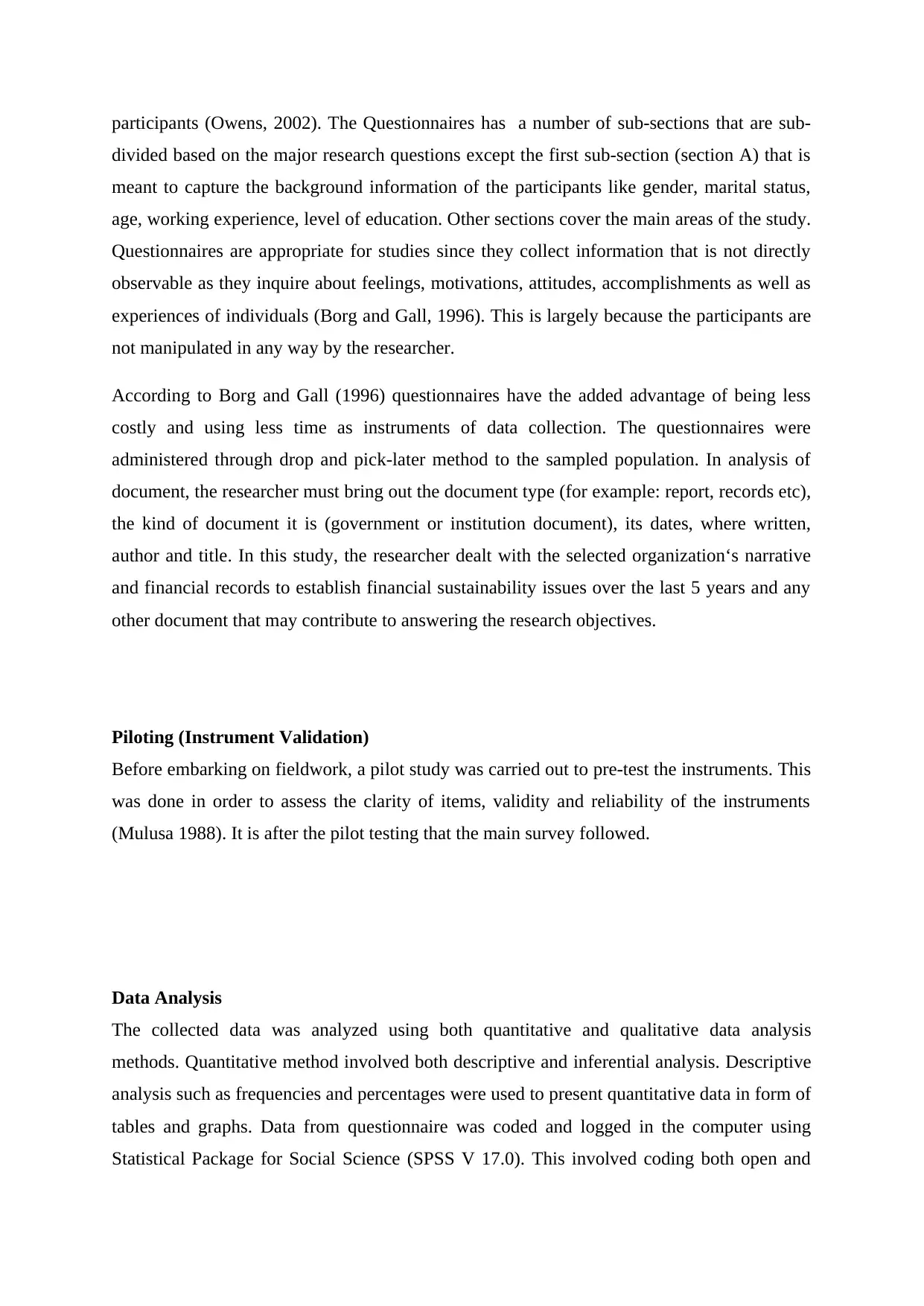
participants (Owens, 2002). The Questionnaires has a number of sub-sections that are sub-
divided based on the major research questions except the first sub-section (section A) that is
meant to capture the background information of the participants like gender, marital status,
age, working experience, level of education. Other sections cover the main areas of the study.
Questionnaires are appropriate for studies since they collect information that is not directly
observable as they inquire about feelings, motivations, attitudes, accomplishments as well as
experiences of individuals (Borg and Gall, 1996). This is largely because the participants are
not manipulated in any way by the researcher.
According to Borg and Gall (1996) questionnaires have the added advantage of being less
costly and using less time as instruments of data collection. The questionnaires were
administered through drop and pick-later method to the sampled population. In analysis of
document, the researcher must bring out the document type (for example: report, records etc),
the kind of document it is (government or institution document), its dates, where written,
author and title. In this study, the researcher dealt with the selected organization‘s narrative
and financial records to establish financial sustainability issues over the last 5 years and any
other document that may contribute to answering the research objectives.
Piloting (Instrument Validation)
Before embarking on fieldwork, a pilot study was carried out to pre-test the instruments. This
was done in order to assess the clarity of items, validity and reliability of the instruments
(Mulusa 1988). It is after the pilot testing that the main survey followed.
Data Analysis
The collected data was analyzed using both quantitative and qualitative data analysis
methods. Quantitative method involved both descriptive and inferential analysis. Descriptive
analysis such as frequencies and percentages were used to present quantitative data in form of
tables and graphs. Data from questionnaire was coded and logged in the computer using
Statistical Package for Social Science (SPSS V 17.0). This involved coding both open and
divided based on the major research questions except the first sub-section (section A) that is
meant to capture the background information of the participants like gender, marital status,
age, working experience, level of education. Other sections cover the main areas of the study.
Questionnaires are appropriate for studies since they collect information that is not directly
observable as they inquire about feelings, motivations, attitudes, accomplishments as well as
experiences of individuals (Borg and Gall, 1996). This is largely because the participants are
not manipulated in any way by the researcher.
According to Borg and Gall (1996) questionnaires have the added advantage of being less
costly and using less time as instruments of data collection. The questionnaires were
administered through drop and pick-later method to the sampled population. In analysis of
document, the researcher must bring out the document type (for example: report, records etc),
the kind of document it is (government or institution document), its dates, where written,
author and title. In this study, the researcher dealt with the selected organization‘s narrative
and financial records to establish financial sustainability issues over the last 5 years and any
other document that may contribute to answering the research objectives.
Piloting (Instrument Validation)
Before embarking on fieldwork, a pilot study was carried out to pre-test the instruments. This
was done in order to assess the clarity of items, validity and reliability of the instruments
(Mulusa 1988). It is after the pilot testing that the main survey followed.
Data Analysis
The collected data was analyzed using both quantitative and qualitative data analysis
methods. Quantitative method involved both descriptive and inferential analysis. Descriptive
analysis such as frequencies and percentages were used to present quantitative data in form of
tables and graphs. Data from questionnaire was coded and logged in the computer using
Statistical Package for Social Science (SPSS V 17.0). This involved coding both open and
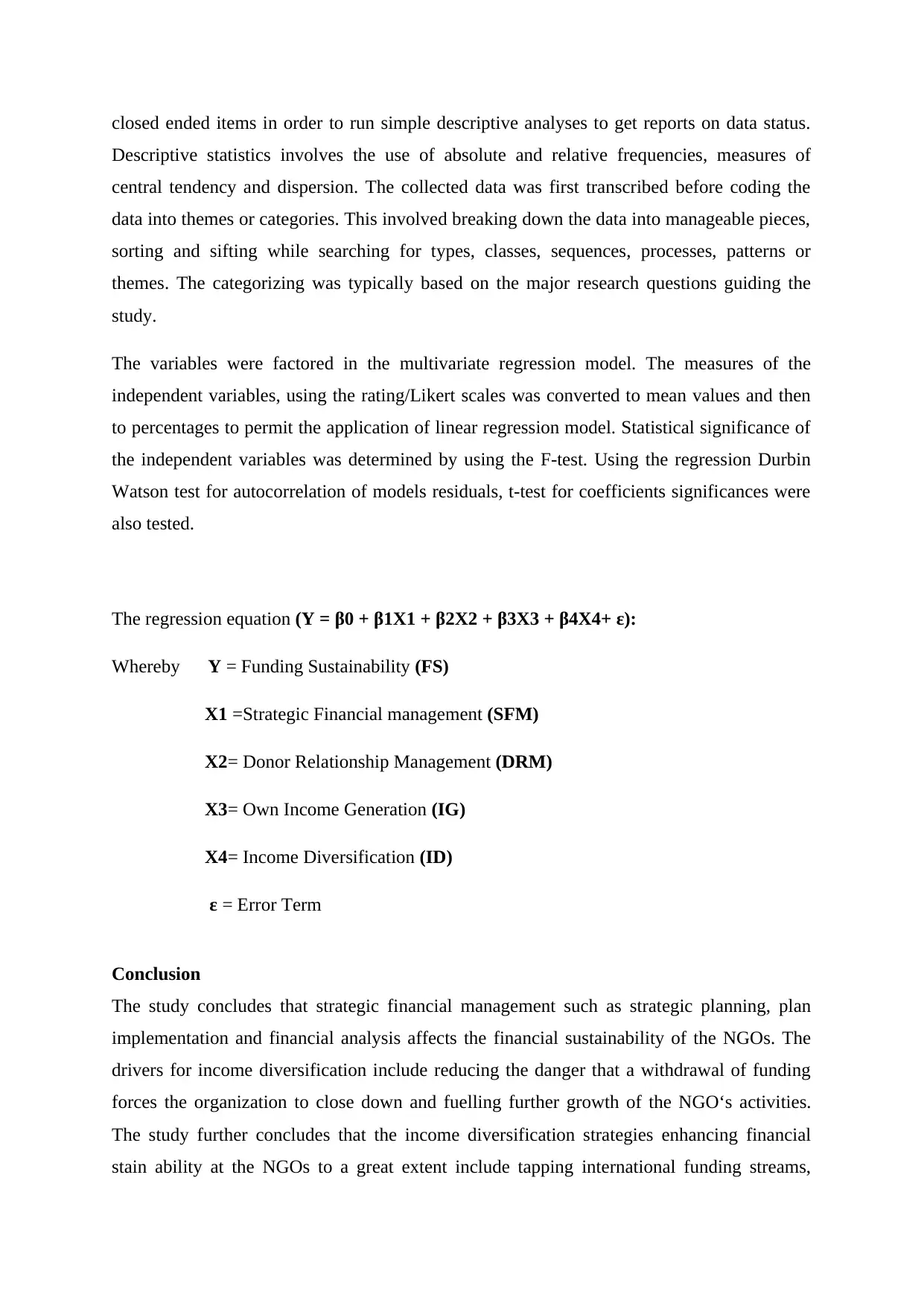
closed ended items in order to run simple descriptive analyses to get reports on data status.
Descriptive statistics involves the use of absolute and relative frequencies, measures of
central tendency and dispersion. The collected data was first transcribed before coding the
data into themes or categories. This involved breaking down the data into manageable pieces,
sorting and sifting while searching for types, classes, sequences, processes, patterns or
themes. The categorizing was typically based on the major research questions guiding the
study.
The variables were factored in the multivariate regression model. The measures of the
independent variables, using the rating/Likert scales was converted to mean values and then
to percentages to permit the application of linear regression model. Statistical significance of
the independent variables was determined by using the F-test. Using the regression Durbin
Watson test for autocorrelation of models residuals, t-test for coefficients significances were
also tested.
The regression equation (Y = β0 + β1X1 + β2X2 + β3X3 + β4X4+ ε):
Whereby Y = Funding Sustainability (FS)
X1 =Strategic Financial management (SFM)
X2= Donor Relationship Management (DRM)
X3= Own Income Generation (IG)
X4= Income Diversification (ID)
ε = Error Term
Conclusion
The study concludes that strategic financial management such as strategic planning, plan
implementation and financial analysis affects the financial sustainability of the NGOs. The
drivers for income diversification include reducing the danger that a withdrawal of funding
forces the organization to close down and fuelling further growth of the NGO‘s activities.
The study further concludes that the income diversification strategies enhancing financial
stain ability at the NGOs to a great extent include tapping international funding streams,
Descriptive statistics involves the use of absolute and relative frequencies, measures of
central tendency and dispersion. The collected data was first transcribed before coding the
data into themes or categories. This involved breaking down the data into manageable pieces,
sorting and sifting while searching for types, classes, sequences, processes, patterns or
themes. The categorizing was typically based on the major research questions guiding the
study.
The variables were factored in the multivariate regression model. The measures of the
independent variables, using the rating/Likert scales was converted to mean values and then
to percentages to permit the application of linear regression model. Statistical significance of
the independent variables was determined by using the F-test. Using the regression Durbin
Watson test for autocorrelation of models residuals, t-test for coefficients significances were
also tested.
The regression equation (Y = β0 + β1X1 + β2X2 + β3X3 + β4X4+ ε):
Whereby Y = Funding Sustainability (FS)
X1 =Strategic Financial management (SFM)
X2= Donor Relationship Management (DRM)
X3= Own Income Generation (IG)
X4= Income Diversification (ID)
ε = Error Term
Conclusion
The study concludes that strategic financial management such as strategic planning, plan
implementation and financial analysis affects the financial sustainability of the NGOs. The
drivers for income diversification include reducing the danger that a withdrawal of funding
forces the organization to close down and fuelling further growth of the NGO‘s activities.
The study further concludes that the income diversification strategies enhancing financial
stain ability at the NGOs to a great extent include tapping international funding streams,
⊘ This is a preview!⊘
Do you want full access?
Subscribe today to unlock all pages.

Trusted by 1+ million students worldwide
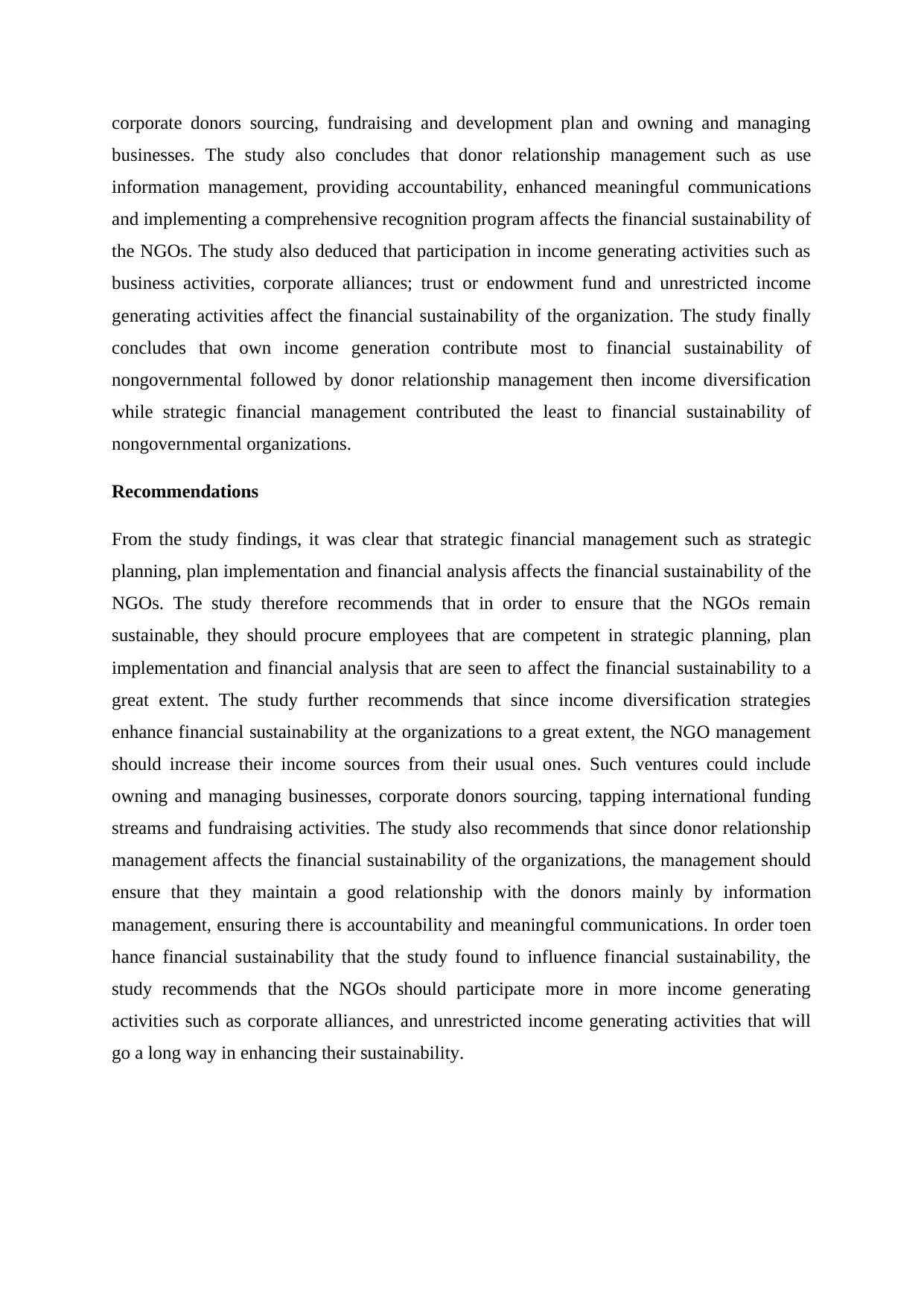
corporate donors sourcing, fundraising and development plan and owning and managing
businesses. The study also concludes that donor relationship management such as use
information management, providing accountability, enhanced meaningful communications
and implementing a comprehensive recognition program affects the financial sustainability of
the NGOs. The study also deduced that participation in income generating activities such as
business activities, corporate alliances; trust or endowment fund and unrestricted income
generating activities affect the financial sustainability of the organization. The study finally
concludes that own income generation contribute most to financial sustainability of
nongovernmental followed by donor relationship management then income diversification
while strategic financial management contributed the least to financial sustainability of
nongovernmental organizations.
Recommendations
From the study findings, it was clear that strategic financial management such as strategic
planning, plan implementation and financial analysis affects the financial sustainability of the
NGOs. The study therefore recommends that in order to ensure that the NGOs remain
sustainable, they should procure employees that are competent in strategic planning, plan
implementation and financial analysis that are seen to affect the financial sustainability to a
great extent. The study further recommends that since income diversification strategies
enhance financial sustainability at the organizations to a great extent, the NGO management
should increase their income sources from their usual ones. Such ventures could include
owning and managing businesses, corporate donors sourcing, tapping international funding
streams and fundraising activities. The study also recommends that since donor relationship
management affects the financial sustainability of the organizations, the management should
ensure that they maintain a good relationship with the donors mainly by information
management, ensuring there is accountability and meaningful communications. In order toen
hance financial sustainability that the study found to influence financial sustainability, the
study recommends that the NGOs should participate more in more income generating
activities such as corporate alliances, and unrestricted income generating activities that will
go a long way in enhancing their sustainability.
businesses. The study also concludes that donor relationship management such as use
information management, providing accountability, enhanced meaningful communications
and implementing a comprehensive recognition program affects the financial sustainability of
the NGOs. The study also deduced that participation in income generating activities such as
business activities, corporate alliances; trust or endowment fund and unrestricted income
generating activities affect the financial sustainability of the organization. The study finally
concludes that own income generation contribute most to financial sustainability of
nongovernmental followed by donor relationship management then income diversification
while strategic financial management contributed the least to financial sustainability of
nongovernmental organizations.
Recommendations
From the study findings, it was clear that strategic financial management such as strategic
planning, plan implementation and financial analysis affects the financial sustainability of the
NGOs. The study therefore recommends that in order to ensure that the NGOs remain
sustainable, they should procure employees that are competent in strategic planning, plan
implementation and financial analysis that are seen to affect the financial sustainability to a
great extent. The study further recommends that since income diversification strategies
enhance financial sustainability at the organizations to a great extent, the NGO management
should increase their income sources from their usual ones. Such ventures could include
owning and managing businesses, corporate donors sourcing, tapping international funding
streams and fundraising activities. The study also recommends that since donor relationship
management affects the financial sustainability of the organizations, the management should
ensure that they maintain a good relationship with the donors mainly by information
management, ensuring there is accountability and meaningful communications. In order toen
hance financial sustainability that the study found to influence financial sustainability, the
study recommends that the NGOs should participate more in more income generating
activities such as corporate alliances, and unrestricted income generating activities that will
go a long way in enhancing their sustainability.
Paraphrase This Document
Need a fresh take? Get an instant paraphrase of this document with our AI Paraphraser
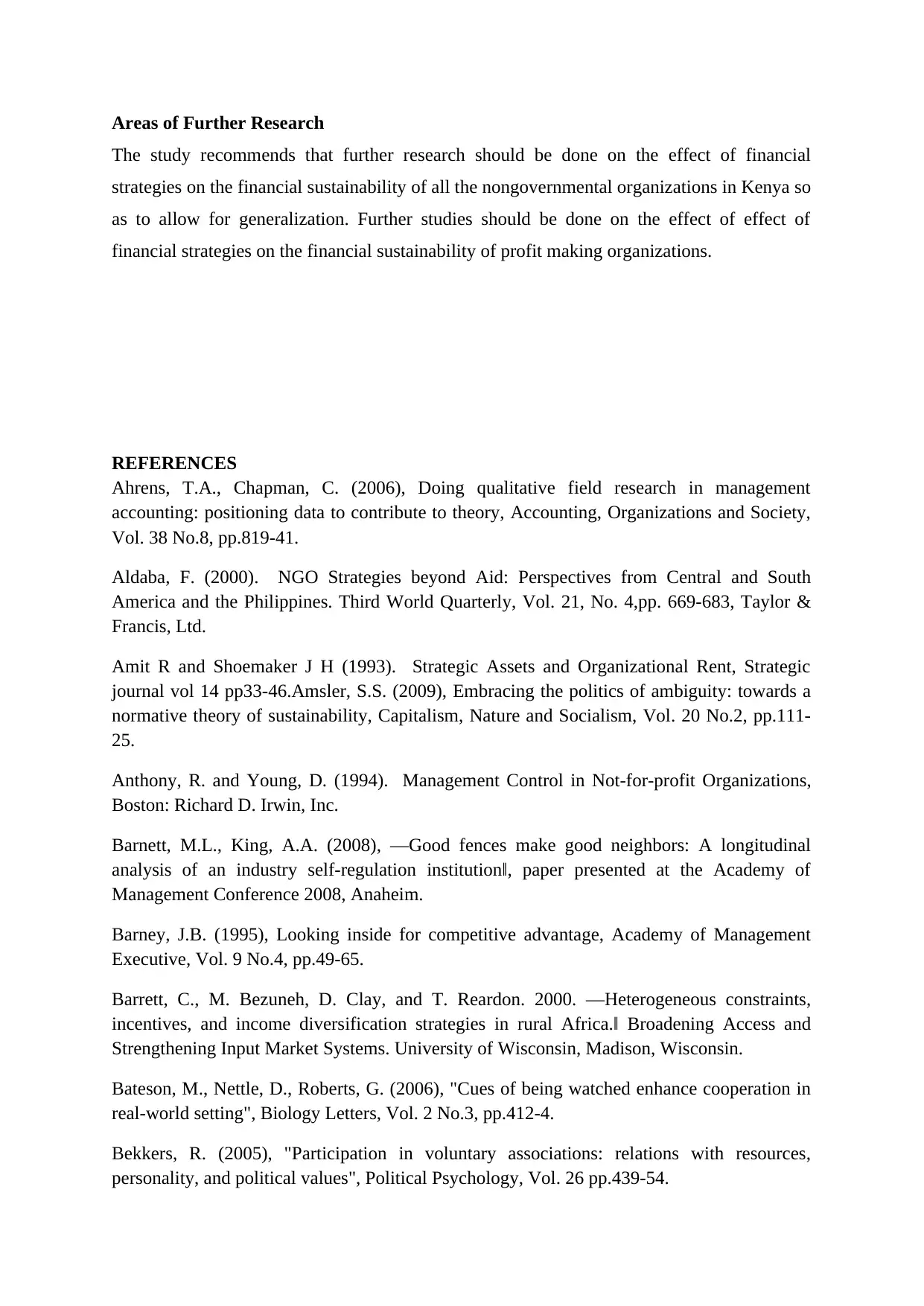
Areas of Further Research
The study recommends that further research should be done on the effect of financial
strategies on the financial sustainability of all the nongovernmental organizations in Kenya so
as to allow for generalization. Further studies should be done on the effect of effect of
financial strategies on the financial sustainability of profit making organizations.
REFERENCES
Ahrens, T.A., Chapman, C. (2006), Doing qualitative field research in management
accounting: positioning data to contribute to theory, Accounting, Organizations and Society,
Vol. 38 No.8, pp.819-41.
Aldaba, F. (2000). NGO Strategies beyond Aid: Perspectives from Central and South
America and the Philippines. Third World Quarterly, Vol. 21, No. 4,pp. 669-683, Taylor &
Francis, Ltd.
Amit R and Shoemaker J H (1993). Strategic Assets and Organizational Rent, Strategic
journal vol 14 pp33-46.Amsler, S.S. (2009), Embracing the politics of ambiguity: towards a
normative theory of sustainability, Capitalism, Nature and Socialism, Vol. 20 No.2, pp.111-
25.
Anthony, R. and Young, D. (1994). Management Control in Not-for-profit Organizations,
Boston: Richard D. Irwin, Inc.
Barnett, M.L., King, A.A. (2008), ―Good fences make good neighbors: A longitudinal
analysis of an industry self-regulation institution‖, paper presented at the Academy of
Management Conference 2008, Anaheim.
Barney, J.B. (1995), Looking inside for competitive advantage, Academy of Management
Executive, Vol. 9 No.4, pp.49-65.
Barrett, C., M. Bezuneh, D. Clay, and T. Reardon. 2000. ―Heterogeneous constraints,
incentives, and income diversification strategies in rural Africa.‖ Broadening Access and
Strengthening Input Market Systems. University of Wisconsin, Madison, Wisconsin.
Bateson, M., Nettle, D., Roberts, G. (2006), "Cues of being watched enhance cooperation in
real-world setting", Biology Letters, Vol. 2 No.3, pp.412-4.
Bekkers, R. (2005), "Participation in voluntary associations: relations with resources,
personality, and political values", Political Psychology, Vol. 26 pp.439-54.
The study recommends that further research should be done on the effect of financial
strategies on the financial sustainability of all the nongovernmental organizations in Kenya so
as to allow for generalization. Further studies should be done on the effect of effect of
financial strategies on the financial sustainability of profit making organizations.
REFERENCES
Ahrens, T.A., Chapman, C. (2006), Doing qualitative field research in management
accounting: positioning data to contribute to theory, Accounting, Organizations and Society,
Vol. 38 No.8, pp.819-41.
Aldaba, F. (2000). NGO Strategies beyond Aid: Perspectives from Central and South
America and the Philippines. Third World Quarterly, Vol. 21, No. 4,pp. 669-683, Taylor &
Francis, Ltd.
Amit R and Shoemaker J H (1993). Strategic Assets and Organizational Rent, Strategic
journal vol 14 pp33-46.Amsler, S.S. (2009), Embracing the politics of ambiguity: towards a
normative theory of sustainability, Capitalism, Nature and Socialism, Vol. 20 No.2, pp.111-
25.
Anthony, R. and Young, D. (1994). Management Control in Not-for-profit Organizations,
Boston: Richard D. Irwin, Inc.
Barnett, M.L., King, A.A. (2008), ―Good fences make good neighbors: A longitudinal
analysis of an industry self-regulation institution‖, paper presented at the Academy of
Management Conference 2008, Anaheim.
Barney, J.B. (1995), Looking inside for competitive advantage, Academy of Management
Executive, Vol. 9 No.4, pp.49-65.
Barrett, C., M. Bezuneh, D. Clay, and T. Reardon. 2000. ―Heterogeneous constraints,
incentives, and income diversification strategies in rural Africa.‖ Broadening Access and
Strengthening Input Market Systems. University of Wisconsin, Madison, Wisconsin.
Bateson, M., Nettle, D., Roberts, G. (2006), "Cues of being watched enhance cooperation in
real-world setting", Biology Letters, Vol. 2 No.3, pp.412-4.
Bekkers, R. (2005), "Participation in voluntary associations: relations with resources,
personality, and political values", Political Psychology, Vol. 26 pp.439-54.
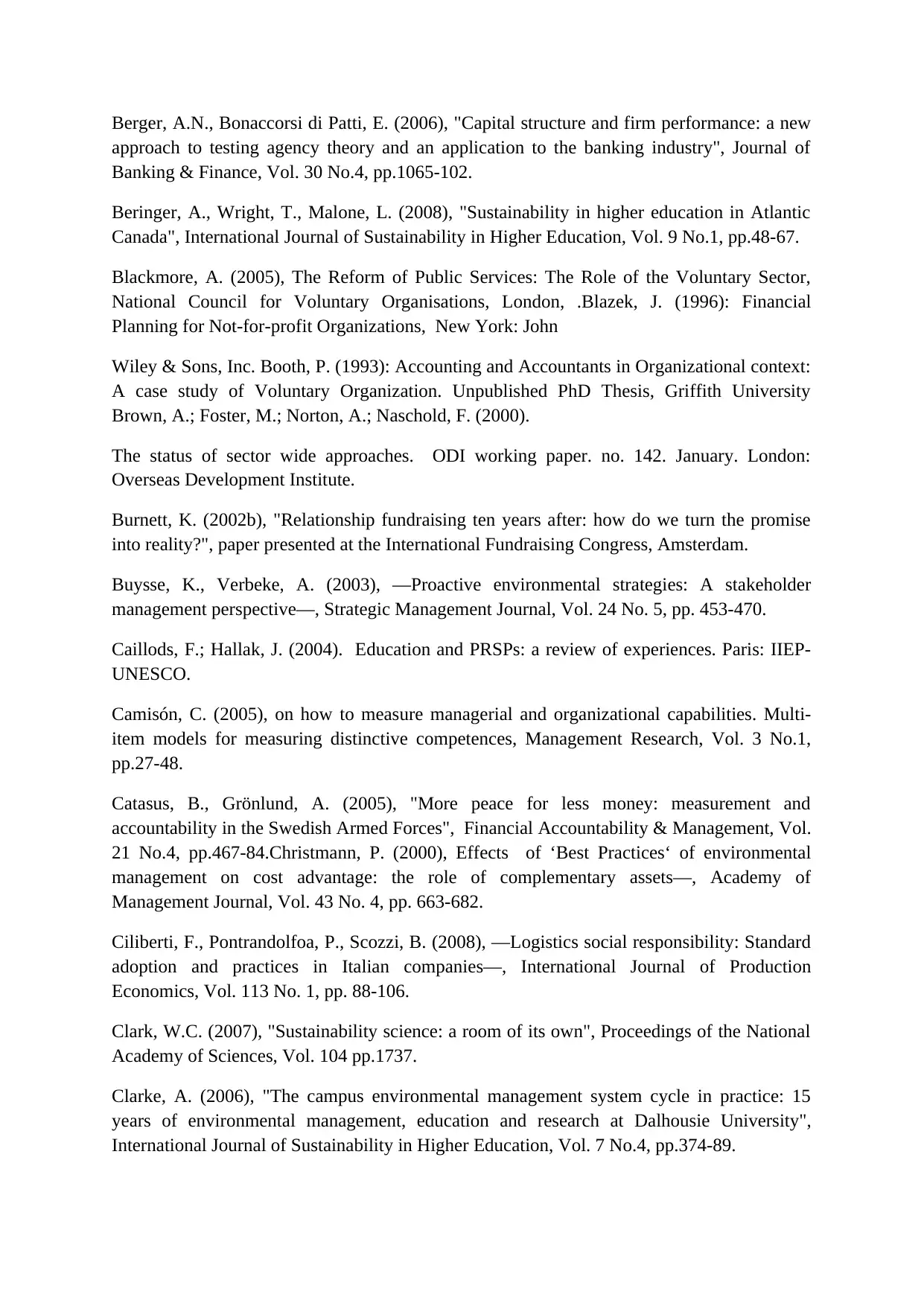
Berger, A.N., Bonaccorsi di Patti, E. (2006), "Capital structure and firm performance: a new
approach to testing agency theory and an application to the banking industry", Journal of
Banking & Finance, Vol. 30 No.4, pp.1065-102.
Beringer, A., Wright, T., Malone, L. (2008), "Sustainability in higher education in Atlantic
Canada", International Journal of Sustainability in Higher Education, Vol. 9 No.1, pp.48-67.
Blackmore, A. (2005), The Reform of Public Services: The Role of the Voluntary Sector,
National Council for Voluntary Organisations, London, .Blazek, J. (1996): Financial
Planning for Not-for-profit Organizations, New York: John
Wiley & Sons, Inc. Booth, P. (1993): Accounting and Accountants in Organizational context:
A case study of Voluntary Organization. Unpublished PhD Thesis, Griffith University
Brown, A.; Foster, M.; Norton, A.; Naschold, F. (2000).
The status of sector wide approaches. ODI working paper. no. 142. January. London:
Overseas Development Institute.
Burnett, K. (2002b), "Relationship fundraising ten years after: how do we turn the promise
into reality?", paper presented at the International Fundraising Congress, Amsterdam.
Buysse, K., Verbeke, A. (2003), ―Proactive environmental strategies: A stakeholder
management perspective―, Strategic Management Journal, Vol. 24 No. 5, pp. 453-470.
Caillods, F.; Hallak, J. (2004). Education and PRSPs: a review of experiences. Paris: IIEP-
UNESCO.
Camisón, C. (2005), on how to measure managerial and organizational capabilities. Multi-
item models for measuring distinctive competences, Management Research, Vol. 3 No.1,
pp.27-48.
Catasus, B., Grönlund, A. (2005), "More peace for less money: measurement and
accountability in the Swedish Armed Forces", Financial Accountability & Management, Vol.
21 No.4, pp.467-84.Christmann, P. (2000), Effects of ‘Best Practices‘ of environmental
management on cost advantage: the role of complementary assets―, Academy of
Management Journal, Vol. 43 No. 4, pp. 663-682.
Ciliberti, F., Pontrandolfoa, P., Scozzi, B. (2008), ―Logistics social responsibility: Standard
adoption and practices in Italian companies―, International Journal of Production
Economics, Vol. 113 No. 1, pp. 88-106.
Clark, W.C. (2007), "Sustainability science: a room of its own", Proceedings of the National
Academy of Sciences, Vol. 104 pp.1737.
Clarke, A. (2006), "The campus environmental management system cycle in practice: 15
years of environmental management, education and research at Dalhousie University",
International Journal of Sustainability in Higher Education, Vol. 7 No.4, pp.374-89.
approach to testing agency theory and an application to the banking industry", Journal of
Banking & Finance, Vol. 30 No.4, pp.1065-102.
Beringer, A., Wright, T., Malone, L. (2008), "Sustainability in higher education in Atlantic
Canada", International Journal of Sustainability in Higher Education, Vol. 9 No.1, pp.48-67.
Blackmore, A. (2005), The Reform of Public Services: The Role of the Voluntary Sector,
National Council for Voluntary Organisations, London, .Blazek, J. (1996): Financial
Planning for Not-for-profit Organizations, New York: John
Wiley & Sons, Inc. Booth, P. (1993): Accounting and Accountants in Organizational context:
A case study of Voluntary Organization. Unpublished PhD Thesis, Griffith University
Brown, A.; Foster, M.; Norton, A.; Naschold, F. (2000).
The status of sector wide approaches. ODI working paper. no. 142. January. London:
Overseas Development Institute.
Burnett, K. (2002b), "Relationship fundraising ten years after: how do we turn the promise
into reality?", paper presented at the International Fundraising Congress, Amsterdam.
Buysse, K., Verbeke, A. (2003), ―Proactive environmental strategies: A stakeholder
management perspective―, Strategic Management Journal, Vol. 24 No. 5, pp. 453-470.
Caillods, F.; Hallak, J. (2004). Education and PRSPs: a review of experiences. Paris: IIEP-
UNESCO.
Camisón, C. (2005), on how to measure managerial and organizational capabilities. Multi-
item models for measuring distinctive competences, Management Research, Vol. 3 No.1,
pp.27-48.
Catasus, B., Grönlund, A. (2005), "More peace for less money: measurement and
accountability in the Swedish Armed Forces", Financial Accountability & Management, Vol.
21 No.4, pp.467-84.Christmann, P. (2000), Effects of ‘Best Practices‘ of environmental
management on cost advantage: the role of complementary assets―, Academy of
Management Journal, Vol. 43 No. 4, pp. 663-682.
Ciliberti, F., Pontrandolfoa, P., Scozzi, B. (2008), ―Logistics social responsibility: Standard
adoption and practices in Italian companies―, International Journal of Production
Economics, Vol. 113 No. 1, pp. 88-106.
Clark, W.C. (2007), "Sustainability science: a room of its own", Proceedings of the National
Academy of Sciences, Vol. 104 pp.1737.
Clarke, A. (2006), "The campus environmental management system cycle in practice: 15
years of environmental management, education and research at Dalhousie University",
International Journal of Sustainability in Higher Education, Vol. 7 No.4, pp.374-89.
⊘ This is a preview!⊘
Do you want full access?
Subscribe today to unlock all pages.

Trusted by 1+ million students worldwide
1 out of 13
Related Documents
Your All-in-One AI-Powered Toolkit for Academic Success.
+13062052269
info@desklib.com
Available 24*7 on WhatsApp / Email
![[object Object]](/_next/static/media/star-bottom.7253800d.svg)
Unlock your academic potential
Copyright © 2020–2025 A2Z Services. All Rights Reserved. Developed and managed by ZUCOL.





